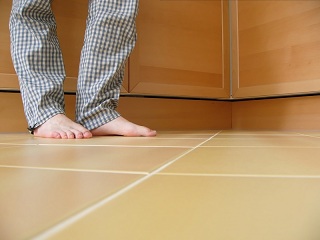
Radiant floor heat is starting to get noticed as a mainstream heating option for homes across the country. Compared to just about every other heating option on the market, including gas furnaces, boilers, electric baseboard heat, and wood fired stoves, a radiant floor heat system provides the most consistent and comfortable home heating solution, period. It is also one of the most energy efficient heating systems, truly an asset in a world gone green.
The Benefits of Radiant Floor System Heat Radiant heating doesn’t create breezes or drafts like forced air heating, which allows you to set the thermostat a few degrees cooler even though the room feels just as warm. If you live in climate where freezing isn’t a concern, you can install solar radiant heating systems that eliminate the need for any kind of fuel based heating systems or a circulating pump, essentially providing free heating once the system is installed. Radiant heat systems don’t spread dust or allergens, they don’t dry out the air, they lose much less heat to outside factors such as drafts or open doors, and they provide a more comfortable, consistent heating experience across the board. How a Radiant Floor Heat System Works A radiant system heats a living space from the ground up. This can be done with either electric or hydronic heating systems that are incorporated into a concrete slab, or installed “dry” beneath your flooring. Each type of system has the same basic end result, but the mechanism of operation is different, so it is important to familiarize yourself with both to choose the one that is right for your home.
Electric Radiant Heating Systems These systems usually consist of electrical heating strips or mats that are laid in patterns across a floor, usually embedded in a thin layer of concrete. The strips or mats heat the concrete, which then radiates heat up into the living area above. Because it’s much cheaper and easier to install, electric radiant heat is especially well-suited if you’re installing radiant heat in small rooms such as a bathrooms under ceramic tile flooring, and for remodels in previously constructed homes.
Hydronic Radiant Heating Systems These are more efficient than electrical ones, but also a much larger project to install. In hydronic radiant heating systems, hot water is pumped through a series of pipes that are laid underneath the floor. Like electric radiant heat, hydronic systems are most often incorporated into a concrete slab which radiates the heat up into the room above. Unlike electric systems, however, it doesn’t matter which type of concrete you use or how thick the slab is.
It might not sound like a big deal, but when it comes to radiant floor heat, thicker concrete means more efficient heating. A thicker slab absorbs more heat, puts off more heat, and is less affected by rapid changes in air temperature (such as opening a door to outside). Hydronic radiant heating would be an excellent choice to install under your hardwood floors, particularly if you have a concrete slab foundation.
Dry vs. “Wet” radiant heating systems Hydronic, or “wet”, radiant heat is ideal from an efficiency standpoint, and is the only way to go if you’re planning a heating system for a new home. If you’re working with a pre-existing structure, however, pouring new slabs of concrete might not be a viable option. Dry systems can be installed anywhere, under any flooring surface from cork tiles to stone floor tiles, without having to encase the heating tubes or coils in a concrete slab.
Whether you’re planning a new home build or just want to enjoy the innovative heating experience of radiant floor heat, this system will save you loads of energy and money. What a wonderful opportunity to go green!





